
- •TABLE OF CONTENTS
- •Chapter 1 INTRODUCTION
- •The es-ice Environment
- •es-ice Meshing Capabilities
- •Tutorial Structure
- •Trimming Tutorial Overview
- •Required Files
- •Trimming Tutorial files
- •Automatic 2D Tutorial files
- •Wall Temperature Tutorial files
- •Mesh Replacement Tutorial files
- •Multiple Cylinder Tutorial files
- •Closed-Cycle Tutorial files
- •Sector Tutorial files
- •Two-Stroke Tutorial files
- •Mapping Tutorial files
- •ELSA Tutorial files
- •Chapter 2 SURFACE PREPARATION IN STAR-CCM+
- •Importing and Scaling the Geometry
- •Creating Features
- •Defining Surfaces
- •Remeshing and Exporting the Geometry
- •Chapter 3 GEOMETRY IMPORT AND VALVE WORK
- •Importing the Surfaces
- •Modelling the Valves
- •Saving the Model
- •Chapter 4 MESHING WITH THE TRIMMING METHOD
- •Modifying Special Cell Sets in the Geometry
- •Defining Flow Boundaries
- •Creating the 2D Base Template
- •Creating the 3D Template
- •Trimming the 3D Template to the Geometry
- •Improving cell connectivity
- •Assembling the Trimmed Template
- •Running Star Setup
- •Saving the Model
- •Chapter 5 CREATING AND CHECKING THE MESH
- •Chapter 6 STAR SET-UP in es-ice
- •Load Model
- •Analysis Set-up
- •Valve Lifts
- •Assembly
- •Combustion
- •Initialization
- •Cylinder
- •Port 1 and Port 2
- •Boundary Conditions
- •Cylinder
- •Port and Valve 1
- •Port and Valve 2
- •Global settings
- •Post Set-up
- •Cylinder
- •Port 1 and Port 2
- •Global settings
- •Time Step Control
- •Write Data
- •Saving the Model
- •Chapter 7 STAR SET-UP in pro-STAR
- •Using the es-ice Panel
- •Setting Solution and Output Controls
- •File Writing
- •Chapter 8 RUNNING THE STAR SOLVER
- •Running in Serial Mode
- •Running in Parallel Mode
- •Running in Parallel on Multiple Nodes
- •Running in Batch
- •Restarting the Analysis
- •Chapter 9 POST-PROCESSING: GENERAL TECHNIQUES
- •Creating Plots with the es-ice Graph Tool
- •Calculating Apparent Heat Release
- •Plotting an Indicator Diagram
- •Calculating Global Engine Quantities
- •Creating a Velocity Vector Display
- •Creating an Animation of Fuel Concentration
- •Creating an Animation of Temperature Isosurfaces
- •Chapter 10 USING THE AUTOMATIC 2D TEMPLATE
- •Importing the Geometry Surface
- •Defining Special Cell Sets in the Geometry
- •Modelling the Valves
- •Creating the Automatic 2D Template
- •Refining the 2D Template Around the Injector
- •Adding Features to the Automatic 2D Template
- •Using Detailed Automatic 2D Template Parameters
- •Saving the es-ice Model File
- •Chapter 11 MULTIPLE-CYCLE ANALYSIS
- •Setting Up Multiple Cycles in es-ice
- •Setting Up Multiple Cycles in pro-STAR
- •Chapter 12 HEAT TRANSFER ANALYSIS
- •Resuming the es-ice Model File
- •Mapping Wall Temperature
- •Exporting Wall Heat Transfer Data
- •Saving the es-ice Model File
- •Cycle-averaging Wall Heat Transfer Data
- •Post-processing Wall Heat Transfer Data in pro-STAR
- •Plotting average wall boundary temperatures
- •Plotting average heat transfer coefficients
- •Plotting average near-wall gas temperature at Y-plus=100
- •Mapping Heat Transfer Data to an Abaqus Model via STAR-CCM+
- •Chapter 13 MESH REPLACEMENT
- •Preparing the File Structure
- •Rebuilding the Dense Mesh
- •Creating Ahead Files for the Dense Mesh
- •Defining Mesh Replacements
- •Setting Up Mesh Replacement in pro-STAR
- •Setting up the coarse model
- •Setting up the dense model
- •Chapter 14 MULTIPLE CYLINDERS
- •Resuming the es-ice Model File
- •Making, Cutting and Assembling the Template
- •Setting Up Multiple Cylinders
- •Checking the Computational Mesh
- •STAR Set-Up in es-ice
- •Analysis set-up
- •Assembly
- •Combustion
- •Initialization
- •Boundary Conditions
- •Post Setup
- •Time Step Control
- •Write Data
- •Saving the es-ice Model File
- •Importing the Geometry
- •Generating the Closed-Cycle Polyhedral Mesh
- •Assigning shells to geometry cell sets
- •Specifying General, Events and Cylinder parameters
- •Creating a spray-optimised mesh zone
- •Importing a user intermediate surface
- •Checking the spray-optimised zone
- •Creating the closed-cycle polyhedral mesh
- •Running Star Setup
- •Creating and checking the computational mesh
- •Saving the Model File
- •Chapter 16 DIESEL ENGINE: SECTOR MODEL
- •Importing the Bowl Geometry
- •Defining the Bowl Shape
- •Defining the Fuel Injector
- •Creating the 2D Template
- •Creating the Sector Mesh
- •Creating and Checking the Mesh
- •Saving the Model
- •Chapter 17 DIESEL ENGINE: STAR SET-UP IN es-ice and pro-STAR
- •STAR Set-up in es-ice
- •Load model
- •Analysis setup
- •Assembly
- •Combustion
- •Initialization
- •Boundary conditions
- •Post setup
- •Time step control
- •Write data
- •Saving the Model File
- •STAR Set-up in pro-STAR
- •Using the es-ice Panel
- •Selecting Lagrangian and Liquid Film Modelling
- •Setting up the Fuel Injection Model
- •Setting up the Liquid Film Model
- •Setting up Analysis Controls
- •Writing the Geometry and Problem Files and Saving the Model
- •Chapter 18 DIESEL ENGINE: POST-PROCESSING
- •Creating a Scatter Plot
- •Creating a Spray Droplet Animation
- •Chapter 19 TWO-STROKE ENGINES
- •Importing the Geometry
- •Meshing with the Trimming Method
- •Assigning shells to geometry cell sets
- •Creating the 2D template
- •Creating the 3D template
- •Trimming the 3D template to the geometry
- •Assembling the trimmed template
- •Running Star Setup
- •Checking the mesh
- •STAR Set-up in es-ice
- •Analysis setup
- •Assembly
- •Combustion
- •Initialization
- •Boundary conditions
- •Post setup
- •Time step control
- •Write data
- •Saving the es-ice Model File
- •Chapter 20 MESHING WITH THE MAPPING METHOD
- •Creating the Stub Surface in the Geometry
- •Creating the 2D Base Template
- •Creating the 3D Template
- •General Notes About Edges and Splines
- •Creating Edges and Splines Near the Valve Seat
- •Creating the Remaining Edges and Splines
- •Creating Patches
- •The Mapping Process
- •Chapter 21 IMPROVING THE MAPPED MESH QUALITY
- •Creating Plastered Cells
- •Chapter 22 PISTON MODELING
- •Meshing the Piston with the Shape Piston Method
- •Chapter 23 ELSA SPRAY MODELLING
- •Importing the Bowl Geometry
- •Defining the Bowl Shape
- •Setting the Events and Cylinder Parameters
- •Creating the Spray Zone
- •Creating the Sector Mesh
- •STAR Set-up in es-ice
- •Load model
- •Analysis setup
- •Assembly
- •Combustion
- •Initialization
- •Boundary Conditions
- •Time step control
- •Write data
- •Saving the Model File
- •STAR Set-up in pro-STAR
- •Using the es-ice panel
- •Activating the Lagrangian model
- •Defining the ELSA scalars
- •Setting up the Lagrangian droplets
- •Defining boundary regions and boundary conditions
- •Setting up analysis controls
- •Adding extended data for the ELSA model
- •Writing the Geometry and Problem Files and Saving the Model
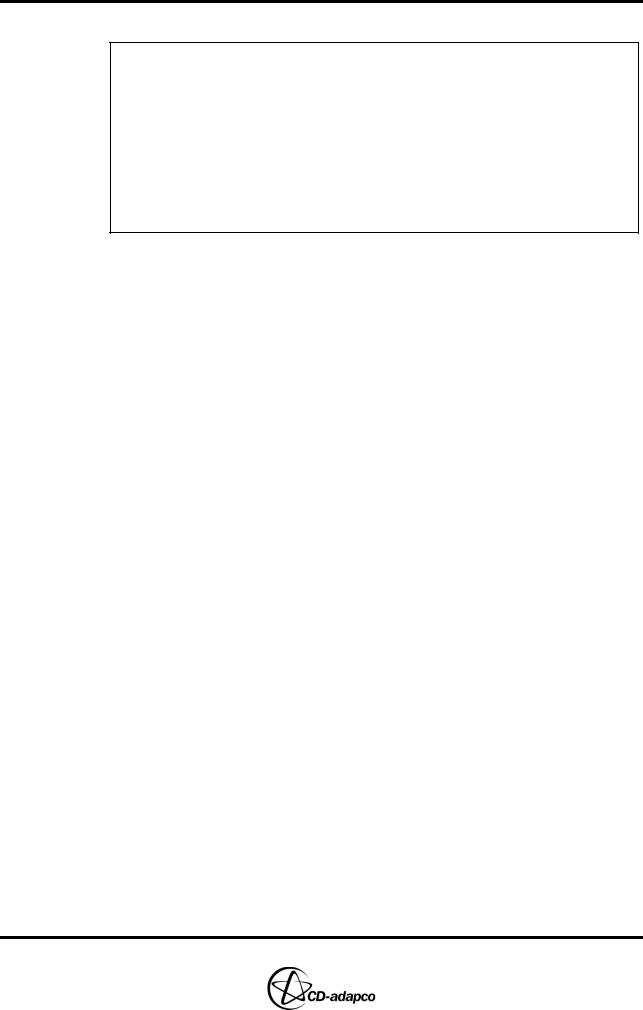
Chapter 10 |
USING THE AUTOMATIC 2D TEMPLATE |
Chapter 10 USING THE AUTOMATIC 2D TEMPLATE
The following tutorial data files are used in this chapter:
AUTO_2D/geometry.dbs
AUTO_2D/vlift01.dat (Valve 1 lift profile)
AUTO_2D/vlift02.dat (Valve 2 lift profile)
AUTO_2D/vlift03.dat (Valve 3 lift profile)
AUTO_2D/vlift04.dat (Valve 4 lift profile)
PANELS/training.pnl
The model created at the end of this tutorial is saved to file: save_es-ice.auto2d
This tutorial demonstrates the process of generating a 2D base mesh using the automatic 2D template feature. This generates an unstructured uniform mesh for each valve section that is much quicker to produce compared to the manual method of creating structured meshes. The automatic method is also better suited to complex cylinder geometries, as you are not constrained by the requirements of structured meshes.
The problem in this case is a diesel engine with a flat cylinder head and one injector in the centre of the cylinder. These characteristics make the geometry ideal for automatic 2D template meshing.
The tutorial highlights several capabilities of automatic 2D template meshing, giving you the ability to rapidly produce high-quality, unstructured meshes. These capabilities include:
•Simple input parameters for producing an initial mesh
•Mesh refinement with a user-defined point, radius and mesh size multiplier
•Inclusion of features on the cylinder head, by placing a mesh line on important details and thus improving cell quality in these areas
•Additional input parameters for greater control over the mesh generation
The steps necessary to set up the tutorial are summarised below:
1.Importing the geometry surface
2.Modifying special cell sets in the geometry
3.Modeling the valve
4.Creating the automatic 2D template
5.Refining the 2D template around the injector
6.Adding features to the automatic 2D template
7.Using additional parameters for detailed control of the automatic 2D template creation
As a prerequisite, it is recommended that you complete Chapter 3 of this volume to familiarize yourself with the es-ice facilities for importing the engine geometry and modelling valves.
Version 4.20 |
10-1 |
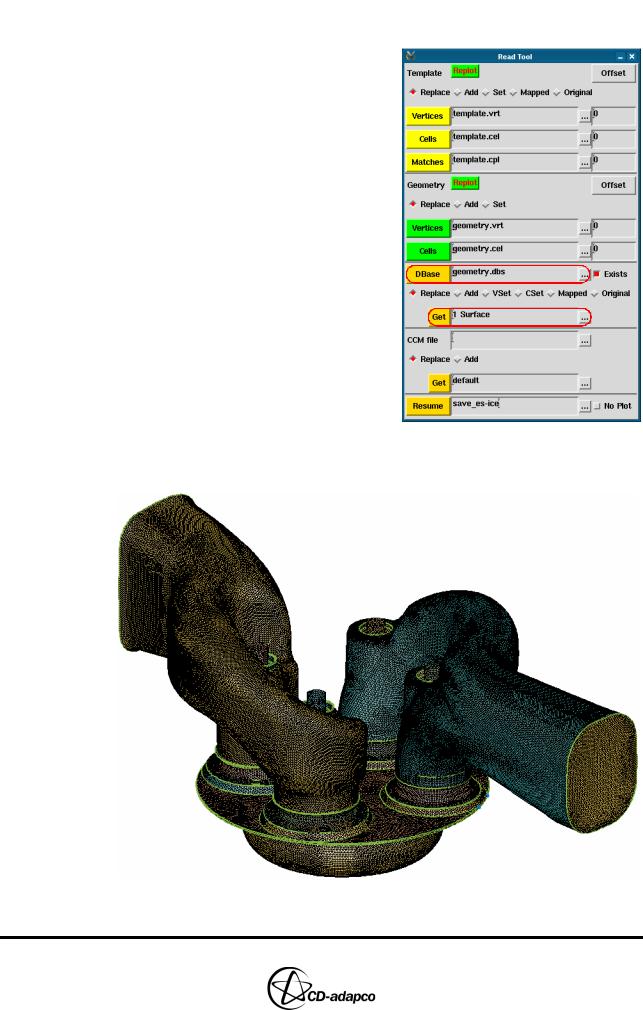
USING THE AUTOMATIC 2D TEMPLATE |
Chapter 10 |
Importing the Geometry Surface |
|
|
|
Importing the Geometry Surface
To import the geometry surface mesh:
•Launch es-ice in the usual manner
•In the Select panel, click Read Data
•In the Read Tool, click the ellipsis (...) next to the DBase box and select geometry.dbs via the file browser
•Click the ellipsis (...) next to the Get box and select 1 Surface via the database browser
•In the Plot Tool, click CPlot
The engine geometry surface will appear in the Geometry window as shown in Figure 10-1
Figure 10-1 Geometry window: Imported geometry surface
10-2 |
Version 4.20 |
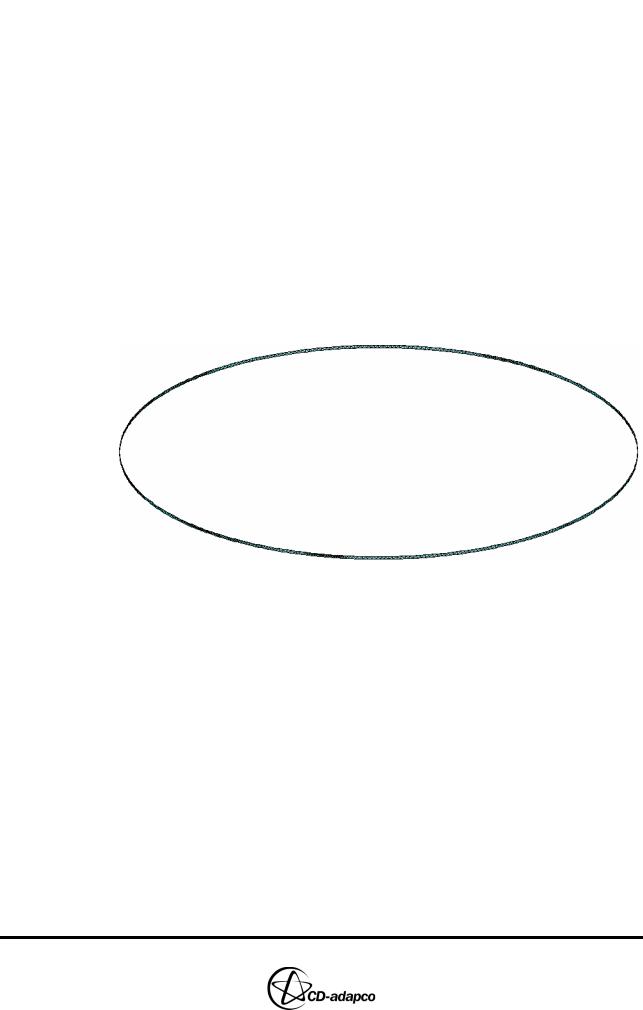
Chapter 10 |
USING THE AUTOMATIC 2D TEMPLATE |
|
Defining Special Cell Sets in the Geometry |
|
|
Defining Special Cell Sets in the Geometry
In the following steps, you will use the supplied training user panel to issue the appropriate commands instead of typing them into es-ice (see Chapter 2, “User panels” in the User Guide volume).
To open the training panel:
•From the menu bar, select Panels > Directory
•Enter the directory location of the supplied user panel (training.pnl)
•From the menu bar, select Panels > training
Next, you need to modify three special, numbered cell sets that identify certain key surfaces on the geometry.
•Enter the following command to isolate the cylinder cells, as shown in Figure 10-2
CSet, Newset, Type, Cursor
Figure 10-2 Cylinder shell selection
•In the training panel, click Cylinder Shells to save the cylinder wall shells to
CSet 1
•Repeat the previous steps to save the piston shells to Piston Shells and the entire trimming surface to Trimming Shells, as shown in Figure 10-3 and Figure 10-4.
•Note that the trimming shells include all the geometry surface shells and line cells but do not include the valves (these are modelled in the next section).
Version 4.20 |
10-3 |
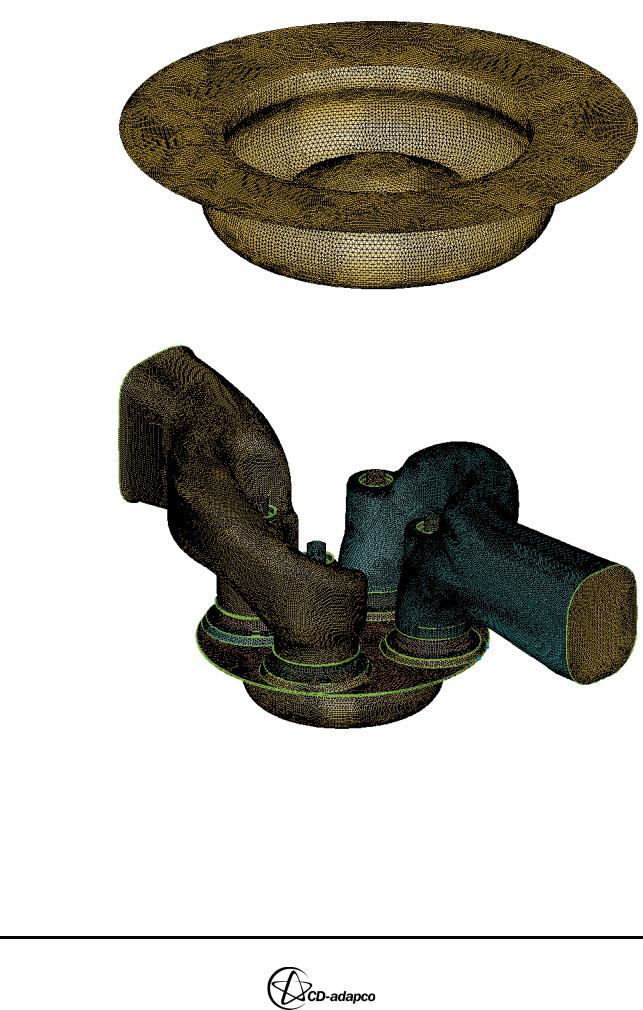
USING THE AUTOMATIC 2D TEMPLATE |
Chapter 10 |
Modelling the Valves |
|
|
|
Figure 10-3 Piston shell selection
Figure 10-4 Trimming shell selection
Modelling the Valves
Generally, valve modelling in es-ice determines the valve shape and the direction of valve motion. For the automatic 2D template, this step defines a ring of vertices on the valve diameter that facilitate the valve motion.
To model the valves:
10-4 |
Version 4.20 |
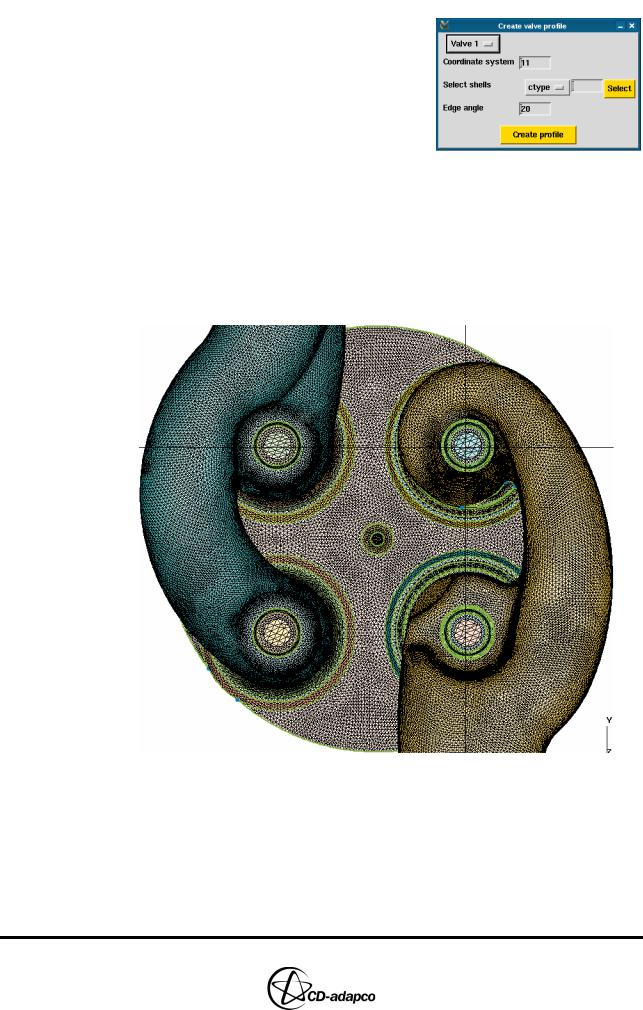
Chapter 10 |
USING THE AUTOMATIC 2D TEMPLATE |
|
Modelling the Valves |
|
|
•Enter the following command to collect all geometry shells into the current CSet
CSet, All
•Make sure the Geometry window is active and then choose a more suitable viewpoint by entering:
View, 0, 0, 1
•In the Select panel, click Create Template
•In the Create Template panel, click Valve profile
•In the Create valve profile panel, ensure that Valve 1 is selected from the drop-down menu and the Coordinate system is set to 11
•Click Select and then pick the Valve 1 surface shells (+x, +y quadrant) in the Geometry window, as shown in Figure 10-5.
Figure 10-5 Selecting Valve 1
•Click Create profile
•Repeat the previous steps for Valve 2 (-x, +y quadrant), Valve 3 (-x, -y quadrant), and Valve 4 (+x, -y quadrant). In each case, make sure you select Valve 2, Valve 3 and Valve 4 from the drop-down menu in the Create valve profile panel.
Creating valve profiles generates a spline representing the calculated shape of the
Version 4.20 |
10-5 |
